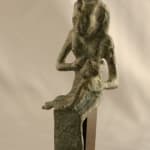Late Period Egyptian Bronze Sculpture of Isis and Horus, 600 BCE - 300 BCE
Bronze
1.75 x 5.75
CK.0164
Further images
The Late Period was the last phase of Egyptian dynastic domination. It is characterised by the see-sawing of power between Egypt and various Middle Eastern groups, notably the Persians. This...
The Late Period was the last phase of Egyptian dynastic domination. It is characterised by the see-sawing of power between Egypt and various Middle Eastern groups, notably the Persians. This period saw Egypt conquered twice, at the end of the 26th dynasty, and again – following a rebellion under the Amyrtaeus, Prince of Sais – in the thirtieth dynasty. While political power was waning, cultural trends were highly dynamic, with numerous external influences, allied with conservative trends – especially surrounding funerary issues – that conspired to produce a highly distinctive artistic heritage. The arrival of the Roman legions was perhaps the greatest single cultural change Egypt had ever experienced.
In the mythology of Egypt, Isis was the protective mother goddess whose lap was a metaphor for the throne of the kingdom, while her son Horus was represented on earth by the living Pharaoh. Furthermore, Isis was the bride of Osiris, the healer, the protector of women, the winged goddess able to grant immortality. The word, “Isis,” is actually the Greek version of her older Egyptian name, Aset or Eset, revealing that she remained a popular deity during the Ptolemaic period, associated with Demeter. According to the story of Isis and Osiris, Horus, the falcon- headed god of the sky, was conceived by Isis from the resurrected soul of her husband Osiris and brought up to avenge his father's murder at the hands of his uncle Seth. Upon successfully subduing Seth, he reclaimed his rightful inheritance, the throne of Egypt. As a result, Horus is associated with the title of kingship, the personification of divine and regal power.
Here, Horus the infant is represented in his human form seated upon his mother’s lap. She wears a tri-partite wig.
Atop the wig is the goddess’s principal attribute in the form of a cylindrical modius fronted by a uraeus which serves to support the cow’s horns cradling the sun disc. The cow’s horns and sun disc were once the exclusive emblem of the goddess Hathor. Due to the syncretistic nature of ancient Egyptian religion over time, the sun disc and cow’s horns were gradually incorporated into the regalia of other goddesses whose characteristics also began to merge with those of Hathor. Although the persons depicted are divine, this beautiful work of art still presents a universal image of tender maternity.
In the mythology of Egypt, Isis was the protective mother goddess whose lap was a metaphor for the throne of the kingdom, while her son Horus was represented on earth by the living Pharaoh. Furthermore, Isis was the bride of Osiris, the healer, the protector of women, the winged goddess able to grant immortality. The word, “Isis,” is actually the Greek version of her older Egyptian name, Aset or Eset, revealing that she remained a popular deity during the Ptolemaic period, associated with Demeter. According to the story of Isis and Osiris, Horus, the falcon- headed god of the sky, was conceived by Isis from the resurrected soul of her husband Osiris and brought up to avenge his father's murder at the hands of his uncle Seth. Upon successfully subduing Seth, he reclaimed his rightful inheritance, the throne of Egypt. As a result, Horus is associated with the title of kingship, the personification of divine and regal power.
Here, Horus the infant is represented in his human form seated upon his mother’s lap. She wears a tri-partite wig.
Atop the wig is the goddess’s principal attribute in the form of a cylindrical modius fronted by a uraeus which serves to support the cow’s horns cradling the sun disc. The cow’s horns and sun disc were once the exclusive emblem of the goddess Hathor. Due to the syncretistic nature of ancient Egyptian religion over time, the sun disc and cow’s horns were gradually incorporated into the regalia of other goddesses whose characteristics also began to merge with those of Hathor. Although the persons depicted are divine, this beautiful work of art still presents a universal image of tender maternity.





